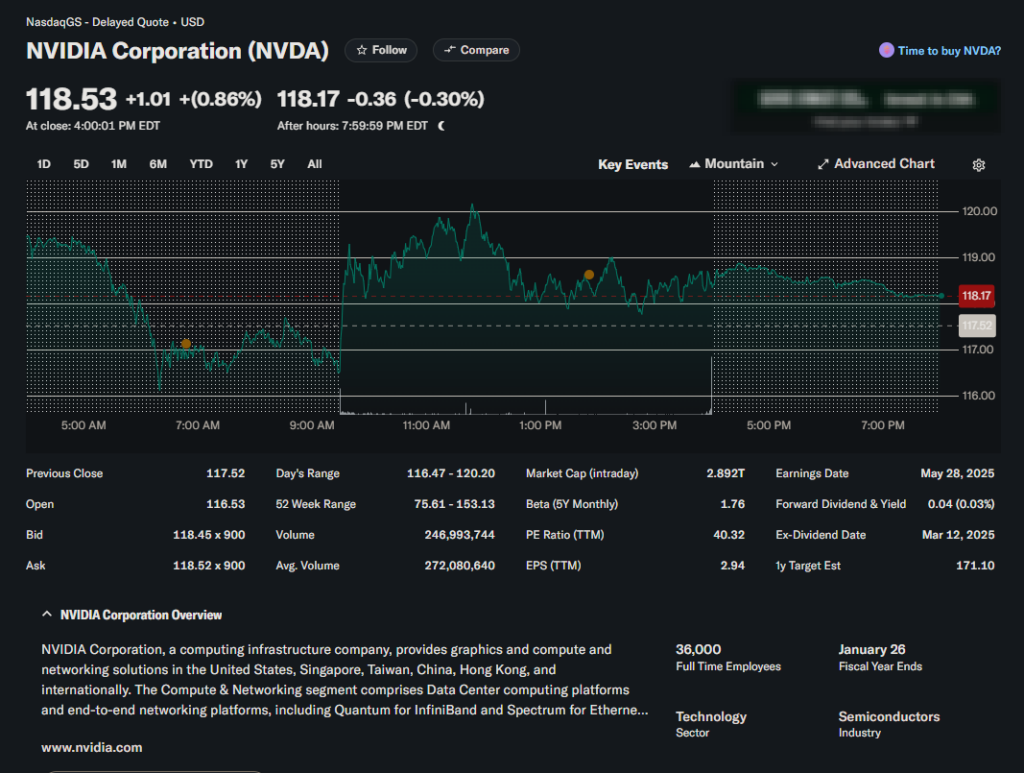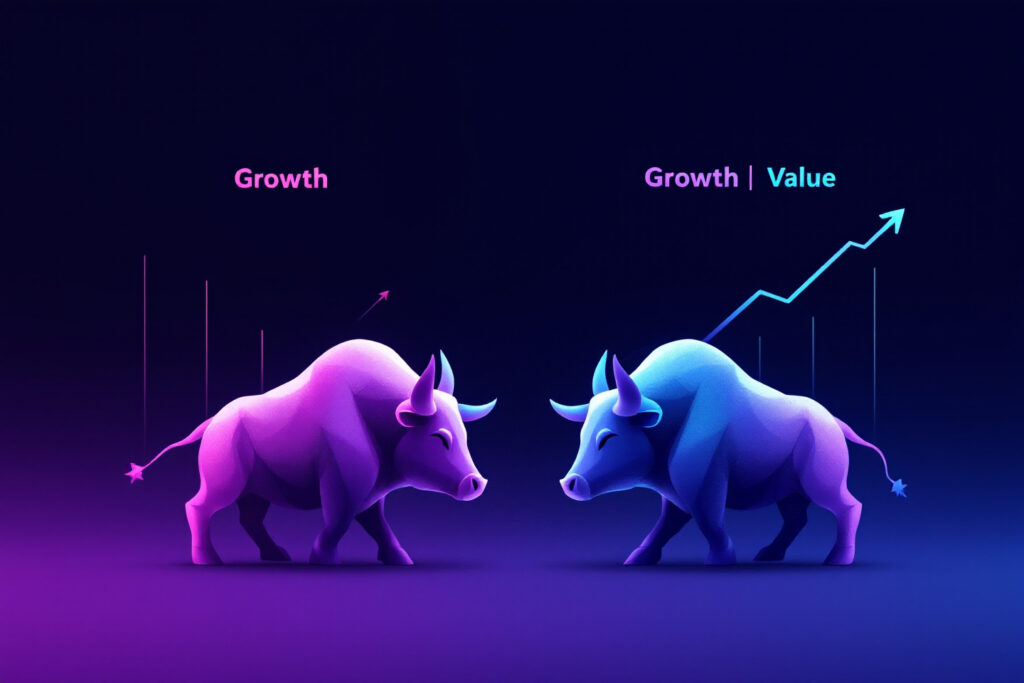In today’s uncertain economic landscape, predicting short-term market movements is nearly impossible. Some analysts warn of a looming recession, citing commercial real estate risks and banking instability. Others remain optimistic, pointing to increased government spending and liquidity driving asset prices higher.
But unless you’re a fortune teller, trying to time the market is rarely successful. Instead, the most effective strategy—especially for long-term investors—is to identify strong, fundamentally sound companies and invest in them consistently.
In this guide, we’ll show you how to analyze top U.S. stocks using Yahoo Finance, with NVIDIA (NVDA) as a real-world example. These insights will help you confidently assess whether a stock is truly worth your investment.
Start with the “Summary” Tab on Yahoo Finance
When you search a company on Yahoo Finance, you’re greeted with a Summary tab that offers a snapshot of the stock’s key metrics. The terminology is mostly straightforward—especially if you’re familiar with basic investing.
Let’s dive into the most important sections.

Key metrics you see on the Summary tab
📌 Bid & Ask: Measure Market Activity and Liquidity
- Bid = the price buyers are willing to pay
- Ask = the price sellers are asking for
- The spread between Bid and Ask reflects the stock’s liquidity
📌 Why It Matters:
A tight spread (small difference) indicates high liquidity, meaning trades are executed quickly at expected prices. A wide spread can indicate low trading volume, higher volatility, and difficulty entering or exiting positions efficiently.
Example:
NVIDIA has a Bid of $118.45 and Ask of $118.52, with a current price of $118.53, it suggests active trading with minimal price slippage. Compare this spread to peers in the same sector—stocks with higher spreads tend to have less investor interest or volume.
📌 Day’s Range & 52-Week Range: Understand Recent and Long-Term Volatility
- Day’s Range: Lowest and highest price of the current trading day
- 52-Week Range: Lowest and highest price over the past year
📌 These ranges help you understand:
✔ Where the current stock price stands relative to recent highs and lows
✔ Whether the stock is near a breakout or overbought level
✔ The general volatility pattern of the stock
Example:
NVIDIA’s 52-week range is $75.61–$153.13, and it’s currently trading at $118.53, the stock is in the middle-upper range of its 1-year high, showing potential room for growth or resistance.
📌 Beta: Gauge the Stock’s Volatility Against the Market
Beta measures how much the stock price moves relative to the market:
- Beta = 1 → Moves in sync with the market
- Beta > 1 → More volatile (riskier, potentially more reward)
- Beta < 1 → Less volatile (safer, steadier returns)
Example:
- NVIDIA’s beta is 1.76 → much more volatile than the broader market
- Compare to Apple (1.18), Microsoft (0.91), Tesla (2.51)
📌 Why It Matters:
- Day traders and aggressive investors may seek high-beta stocks for short-term opportunities
- Long-term investors or those seeking stability might prefer lower-beta, less volatile stocks

PER & EPS: Valuation and Profitability
📌 PER (Price-to-Earnings Ratio)
PER tells you how much investors are willing to pay for $1 of the company’s earnings.
- High PER = market expects future growth
- Low PER = potentially undervalued or low growth expectations
Example:
- NVIDIA PER: 40.32
- Apple: 33.93, Microsoft: 31.15, Tesla: 116.38
A PER of 40+ means NVIDIA is seen as a high-growth stock. Compare PERs within the same industry to spot over- or under-valued stocks.
📌 EPS (Earnings Per Share)
EPS tells you how much net profit the company earned per share.
- Higher EPS = more profitability
- Look for EPS growth over time to identify consistent performers
Example:
- NVIDIA EPS: 2.94
- Apple: 6.31, Microsoft: 12.42, Tesla: 2.03
📌 Investor Tip:
Watch how EPS changes quarter-over-quarter. Rising EPS usually signals improving business health.
Dividends & Earnings Calendar
📆 Earnings Date
Upcoming date when the company will report earnings. Stock prices often move significantly after earnings releases.
💰 Forward Dividend & Yield
Projected annual dividend and its percentage of current price.
- NVIDIA: $0.04 annual dividend (0.03% yield)
- Low yield = common for growth stocks (they reinvest profits instead of paying dividends)
⏰ Ex-Dividend Date
You must own the stock before this date to receive the next dividend.
📌 Dividend stocks can provide passive income, but if you focus on growth, dividends may be less important than earnings expansion and reinvestment.
Investing Isn’t About Guesswork—It’s About Understanding
All of this information is publicly available. The key isn’t just accessing data, but interpreting it:
- A high PER isn’t inherently bad—it may reflect strong future growth
- A high beta stock can be both opportunity and risk depending on your strategy
- Bid-Ask spreads reflect how much confidence investors have in the stock
Too often, investors chase stock prices without understanding what they’re buying. Don’t invest based on hope—invest based on fundamentals.

Use Yahoo Finance to Make Smarter Investment Decisions
Yahoo Finance isn’t just a stock price tracker—it’s a powerful free tool that helps you:
✔ Analyze stock fundamentals
✔ Compare peer companies
✔ Time your entries based on valuations and volatility
If you’re serious about investing in U.S. stocks, mastering the data on Yahoo Finance is a must-have skill.
🧾 “Buy quality companies at fair prices—and let time do the compounding.”
🔜 Coming Soon on the Blog
- “5 Expert Tips to Achieve Financial Freedom“
- “How to Analyze PER, PBR, and ROE Like a Pro”
- “How to Analyze Blue-Chip Stocks Using Yahoo Finance”

